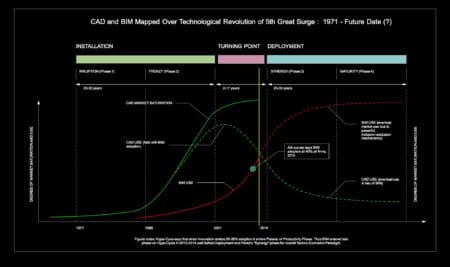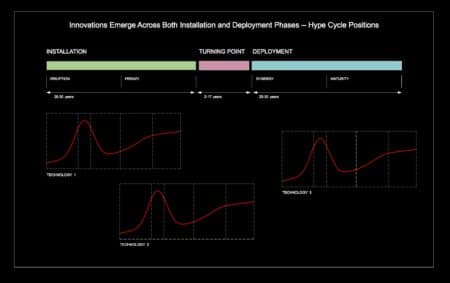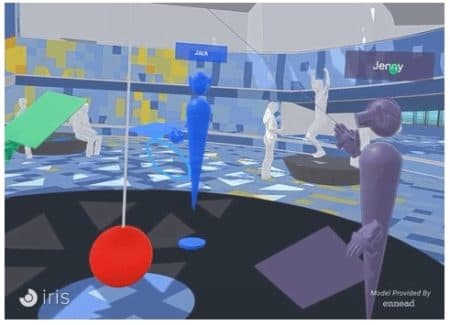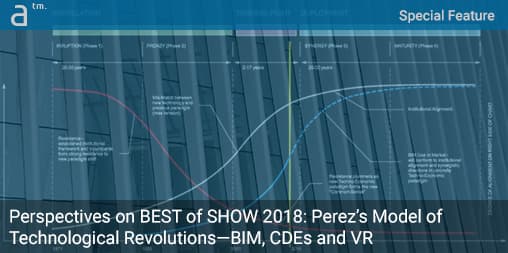Continued from page 3
Part 4: AEC in the Smart Green Future–Roles for BIM, CDEs, VR
Perez’s theory and model of Techno-Economic Paradigms (TEPs) has influenced our thinking about what AEC technologies matter the most from the perspective of forming “synergistic” directions that can lead to the next golden age as described by Perez. As she describes in the videos lectures we linked to above, we are currently just prior to the SYNERGY stage, the first phase that leads to a golden age in the Deployment period. See the yellow line in image 07 below.
BIM (Buiding Information Modeling)
BIM is less a technology than a paradigm shift that appears to have emerged rather early with respect to the SYNERGY and MATURITY phases of DEPLOYMENT {terms used by Perez’s model} (see image 06 above). We recognize BIM as the base “paradigm shift” for the modernization of construction (and production) that Perez advocates for in her vision. Key to that modernization is the role of bridging the digital to fabrication worlds, something that Autodesk has taken a lead on and advocated for in its Project Quantum work and that Phil Bernstein has spoken about with Architosh. (see: Architosh, “Phil Bernstein of Autodesk on the Changing Role of the 21st Century Architect—The Interview (Part 1),” 16 Apr 2016 ) It’s latest Revit 2019 advances that BIM solution strongly in those directions where connections to engineering and fabrication are critical.
From the perspectives of Perez, BIM’s evolutionary vectors involve “democratizing” access into the new model of manufacturing production and AEC construction. It must resist the establishment into a closed system. “I think the choice facing society is between closed economies, highly concentrated and unequal, and open economies with decentralized ownership.” (Johnson/Perez). Perez makes note that the Internet was “originally seen as a vehicle for decentralized ownership and control. Instead, we’ve moved into the era of Google and Facebook, where the algorithm becomes the means of production.”

07 – According to AIA data, BIM adoption is just at 50 percent perhaps this year. However, a lot of the profession does not have plans for BIM adoption but powerful inclusion-exclusion mechanisms will likely emerge that force the remaining AEC professionals into BIM.
Perez’s thinking thus has emphasized in us that the global AEC industry needs to further the cause of democratizing the entire AEC toolchain system. For BIM this means everything from supporting open data interoperability standards like IFC and BCF to the way in which particular BIM apps strive to build connections to other leading tools. In particular, coherence and synergy around more community and open-source-like technologies—those that are tending towards openness and democratization‚ should be encouraged, while those that are proprietary and de-synergistic around competitors should not be emphasized. Perez speaks and writes that the importance of “new consensus-building mechanisms”—and in the AEC world we have some (eg: buildingSMART, Open Design Alliance, The Khronos Group, etc)—are crucial to driving at synergy in the DEPLOYMENT period. (see image 07 and see notes around red line)
We applaud GRAPHISOFT, for example, for its strong advancement of McNeel’s Grasshopper and Rhino for algorithmic design. That toolchain is infused with an open-source-like community where its many leaders and innovators are vested in sharing and distribution. (see: Architosh, “Bespoke Computational Tools at Payette Drive Unforeseen Values for Firm and Client Alike,” 5 Feb 2018) GRAPHISOFT could have chosen to build its own rival tools, much like Autodesk and Vectorworks did, but instead focused on establishing synergy around a democratizing and community-oriented leader.
Some final words about BIM with respect to Perez. During the SYNERGY phase in particular powerful “inclusion-exclusion mechanisms” begin to force alignment with technology innovations as the new “common-sense” takes hold over society. We think these will emerge over the next decade where BIM models move freely between various third-party apps, often in the cloud, and often with very specific functions that begin to connect the creators to the fabricators. When the world of fabrication changes, and it requires digital models, the use of 2D CAD, to the exclusion of 3D BIM, will be minimized in its status within AECO production and operations. This doesn’t mean 2D CAD goes away, it means it finds its remaining optimal purposes. (see the dashed green segment in the curve in image 07 above)
Algorithmic and Computational Design
Seen as both a technology set and model of production, these technologies are crucial to the larger paradigm shift. Perez sees the “algorithm” as a critical piece of the infrastructure of the DEPLOYMENT period of the ICT revolution. But the threat is that market leaders with massive data will close down economic competitors. It is imperative that the “democratization of data”—something our BEST of SHOW perspective has discussed at length—remains a primary concern in the interest of decentralized ownership of what could be referred to as the “digital commons” of a global smart green future. We, therefore, favor open-source directions for algorithmic and computational toolsets, as already mentioned above in the BIM section. And we wish to match up these tools with open and free data.

08 – Our final chart for this article shows how separate technologies arriving at various points within a larger Technological Revolution fall under forces that do specific things to these technologies.
We did not award any specific solutions this year that we have referred to in the past as dedicated APFD (accessible programming for designers) tools or more commonly referred to as algorithmic-aided design (AAD) and visual scripting. Computational design, in general, is becoming embedded into mainline BIM authoring solutions and dispersed through the open-source-like community around Grasshopper.
Meanwhile, we’d like to direct attention to where computational design really stands in the AEC world with respect to the larger technology revolution we are in, according to Perez. Using the Hype-Cycle to represent a particular technology invention, (see 08 above) depending on when an innovation emerges within a larger technology revolution plays a big part in where that innovation goes. Take for example Google X’s Flux. Once a promising player in the computational design space in AEC, the company has pivoted again, this time now heading to the real-estate market rather than AEC. Of the three Hype Cycle curves shown in image 08 above, which one most closely relates to where this space of technologies fits under Perez’ Techno-Economic Paradigm (TEP) model? The answer is none of them. If we are in the Turning Point phase, as Perez says we are, (see yellow line in image 07) the Trough of Disillusionment section of the Hype Cycle (see image 02) needs to align somewhere under the pink bar because computational design is likely still less than 5 percent of adoption within architectural practice.
APFD or AAD in AEC is likely a subset of the AI revolution—an early phase that marks a decisive moment where architects and designers are converted into solution curators and editors rather than designers themselves. This is a generational change and one that requires the AI (artificial intelligence) revolution to advance much further. In the near future architects are going to be “centaur-like” professionals, mixing human intelligence with AI.
CDE (common data environments)
CDEs are a crucial piece of the infrastructure investment and naturally align with the SYNERGY and MATURITY phases of the DEPLOYMENT period in Perez’ model. Early versions of such tools failed at the turn of the century for reasons we may choose to explore in a future article from the perspective of Perez’s writing. In a nutshell, though, Perez might suggest that early web portals for AEC (eg: Buzzsaw) were established too early without sufficient “clustering of innovations” to buttress the early CDE movement. “In other words, the great clusters of talent come forth after the revolution is visible and because it is visible.” (Perez) Significant core technologies in the web browser space and with graphics (eg: WebGL) were all lacking 15 years ago to help power the early document and project management online tools.
CDE’s need to function as connective systems across the whole process transformation. Countries, where these tools will naturally advance quickest, are countries already more closely aligned with visions similar to Perez. (Scandinavia). Such tools have not become the new “common sense” (a Perez term) within the world of architecture but large-scale contractors are very much advancing their working methods using cloud-based CDEs that offer dramatic productivity improvements. CDEs are also finding growth via inclusion-exclusion mechanisms and institutional alignments—like government mandates around BIM usage and the BS1192 standards push.

09 – Autodesk’s APIs are open and connected to other cloud app APIs but the company’s Forge platform is just that—a platform that is proprietary to Autodesk.
It is utterly disappointing to see so little evidence of the CDE revolution in AEC at the largest architecture show in the world’s largest market. In past shows, key players like PlanGrid showed up for AIA National, and we have already awarded honors to Trimble Connect before it belonged to Trimble. But this year it was really only Autodesk who was touting the benefits of a CDE tool in BIM 360.
Autodesk’s BIM 360 CDE is thought of internally by the company more as a “common data platform” and one can see from the image above (image 09) the degree of API connections from largely “construction-facing” technology providers. What we hope to see in the near future is the robust use of connected offerings that link architects’ BIM and 3D models directly to fabricators as one potential attraction to onramp more architects into these tools. While BIM models inside CDEs are the most obvious place to encourage diffusion of this paradigm shift, so too is collaboration and in particular the revolutionary technologies of VR (virtual reality) and AR (augmented reality) and how they can change collaboration.
VR and AR
Multi-person virtual reality meetings are nothing short of transformational; the technology magically teleports the mind into another three-dimensional world where one can both see and interact with other parties in the meeting. Both IrisVR and several of its competitors are gunning to become nothing short of the next evolution of GoTo Meeting. (image 10)

10 – This is a primitive model compared to the high-quality rendered architecture model Pete and myself occupied together at AIA National 2018.
At AIA National 2018 in NYC, both Pete and I spent considerable time both inside the same virtual model at the IrisVR booth. We were standing next to each other but we could have been halfway around the world. All that is required is your own VR-capable computer and ideally a high-quality VR headset like HTC Vive. We had Oculus units on, which are also very good. With audio configured, we could talk to each other just like we can in a GoTo Meeting. With built-in markup tools, we could sketch out changes to architecture in real-time, co-located virtually inside a building site or building, built or unbuilt, and conduct a true collaboration at a 1:1 real-life scale. It is not far off from truly being “there” in person. But in this case, the there may not exist…it is something planned to exist.
Closing Comments
Perez says that during the first phase of the INSTALLATION period—the period known as IRRUPTION—the “technological revolution also signals a cleavage in the fabric of the economy along several lines of tension.” (Perez). Some of these are listed include:
- between the modern firms—whether new or upgraded by the new methods—and the firms that stay attached to the old ways
- between the new industries and the mature (old) industries
- in capabilities, between those that are trained to participate in the new technologies and those whose skills become increasingly obsolete
There are other lines of tension as well, such as the shift of economic power between regions that dominated the economy during the previous technological revolution and the new regions that dominate the new technological revolution (eg: Pittsburg to Detroit to Silicon Valley). Perez’s model actually sheds much light on and argues for, why the news-worthy second Amazon headquarters location should be placed in a city that is trending towards clustering of expertise in AI and robotics. (eg: Pittsburg or Boston)
Perez writes, “So, the INSTALLATION period (see image 06) is one of tense coexistence of two paradigms, one declining and the other occupying more and more space on the ground.”
In studying Carlota Perez with particular attention to the AEC world, one struggles to relate 2D CAD to 3D BIM. The primary problem is that BIM appears to have emerged nearly at the same time as CAD, in terms of solutions offered to the market. (see image 07) Architrion and ARCHICAD and even some others were there in the market with a virtualized building concept. But 2D CAD and electronic drafting ushered in the new in the guise of the old—just as the early automobile appeared from adventurous carriage makers. In a sense, 2D CAD was simply placing a new digital engine on a draftsman-era analog carriage. —- ANTHONY FRAUSTO-ROBLEDO, AIA, LEED AP, Editor-in-Chief
Footnotes
- While we talk about “modulating” practice so that architects have more “design time” and more time to contemplate as part of the socio-artistic aspects of this field, we acknowledge that there are other dimensions not emphasized here that also raise the performance role of architects in society, including their ability to increase responsibilities to owners and operators with regard to construction and operation budgets. Fiscal responsibilities have long been the bane of architects, criticized often, and rightly, for their overzealous personal quests regarding the artistic concerns of their profession.




Reader Comments
Comments for this story are closed